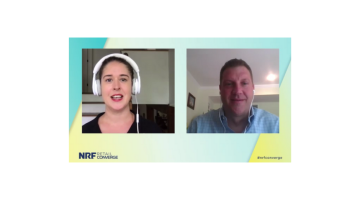When looking for that perfect little black dress, Nordstrom might be the spot for the latest and greatest. As for heading to Nordstrom Rack instead?
“You’re going to go looking for the black dress,” said Nordstrom Rack President Geevy Thomas at NRF Retail Converge, “and you’re going to leave with a shopping cart full of all kinds of things you didn’t know you had to have.”
Nordstrom Rack, which started in the basement of a downtown Seattle Nordstrom, began as a way to clear end-of-season inventory from the full-line stores. Over time, it became the biggest acquisition source for new customers. And today, Nordstrom and Nordstrom Rack are each powerful brands, operating as part of an integrated entity.
“We look at the business holistically, and we look for ways in which we can deliver the best product to the best customer, in the ways that they want to receive it, whether that’s in a mobile app or on the website, or in one of our stores,” said Thomas during a keynote conversation with CNBC retail reporter Lauren Thomas.

president of Nordstrom Rack
Success in co-location
Since its beginnings, he said, the company has learned that customers ebb and flow between the two based on their need states.
When the company opened its flagship Nordstrom Rack store across from its flagship Nordstrom in downtown Seattle, he said, “the Nordstrom store had its best year ever. It’s because Rack attracts a lot of customers. And so, when they come to visit the Rack store, they will make their way across the street to the full-line store, and vice versa. It creates this synergistic thing that we think is really unique in our space.”
That result was more stumbled-upon than planned, he said, but the Nordstrom Rack stores that typically do best have a Nordstrom nearby.
Growth plans
The company recently announced it intends to grow the Nordstrom Rack brand by about $2 billion over the next five years. Overall, the off-price sector is in an aggressive season; besides that, however, “we’re the only retailer that has a full digital complement, as well as omnichannel capabilities and a store platform,” he said.
“We believe that by leveraging the kind of breadth that the online business gives us to widen our aperture on price and the ability to bring easy returns to stores – in fact, 83 percent of our online returns come back to Rack stores – it’s the combination of all of those things that is going to enable us to get to that next $2 billion. Including, we believe, opening more Rack stores, as we have over the last several years.”
In 2010, Nordstrom Rack was roughly a $1.3 billion operation, he said, and it has grown by roughly $2 billion every five years since. The next period will look different than the last two, “but is going to be filled with exciting opportunities to grow both the digital and physical footprints, as well as our mobile capabilities.”
Convenience is as important to the off-price customer as anyone else. Competitors have tackled the issue by opening “thousands of stores” to be physically convenient. Nordstrom Rack, however, has taken another approach.
With locations in the hundreds rather than thousands, Thomas said, “we’re not on every corner at this point, but we are in everybody’s phone. And we are on everybody’s couch, when they’re sitting there with their iPad, or in their work desk. We view convenience as being where they want to shop. And we know people want to shop online. So, we’ve really leaned into that.” Nordstrom Rack continues to be Nordstrom’s fastest growing business.
Accelerated innovation
As for the pandemic, it accelerated a variety of initiatives. Over the past year, the company introduced shared inventory, with the ability to fill all online orders from store inventory as well as fulfillment centers, opening a “whole new plethora of product choices for our consumers online.”
It also enabled next-day BOPIS, ship to store capabilities and the ability for Nordstrom.com items to be shipped to and returned to Nordstrom Rack locations. The Nordstrom Rack website will soon be hosted by the Nordstrom ecommerce platform, taking full advantage of investments made there.
Nordstrom Rack is also experimenting with recommerce, and looking closely at opportunities in smaller markets.
The company used to limit its stores to markets that had between 250,000-500,000 people, Thomas said, but has found it can be successful in smaller communities, too. “We think there’s more opportunity for us to do that,” he said.
“And we look forward to serving those customers, and bringing the digital and physical together for them, wherever they live.”

